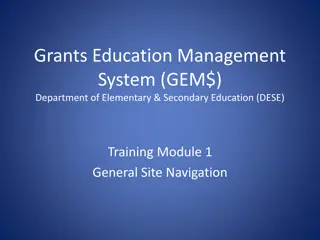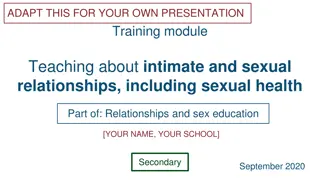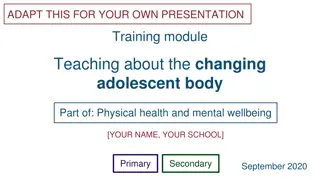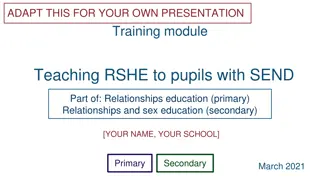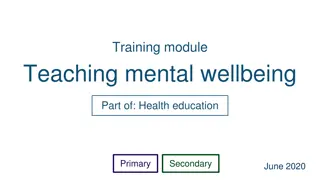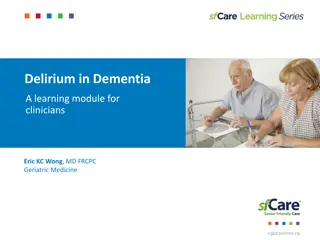Interacting with Family Members
This resource focuses on enhancing communication skills and approaches for family members caring for loved ones with dementia. It covers training goals, responding to upset feelings, the importance of non-verbal messages, and the difference between reacting and responding. Valuable tips are provided to help families navigate emotional distress and improve the quality of care for individuals with dementia.
Download Presentation

Please find below an Image/Link to download the presentation.
The content on the website is provided AS IS for your information and personal use only. It may not be sold, licensed, or shared on other websites without obtaining consent from the author. Download presentation by click this link. If you encounter any issues during the download, it is possible that the publisher has removed the file from their server.
E N D
Presentation Transcript
Interacting with Family Members Partnerships to Improve Care and Quality of Life for Persons with Dementia
Training Goals Goals for our series Enhance family involvement in the daily care of their loved ones Promote person-centered care Goals for today Discuss communication techniques and approaches Identify pitfalls and ways to avoid them Review strategies to help families find solutions to emotional distress
Responding to Upset Feelings Two main steps #1 Understand emotional reactions in the context of stress #2 Help families through their emotional distress Accept the other person s feelings Right or wrong, the feelings are real Disagreeing or correcting can make things worse
Responding to Upset Feelings Apologize for the misunderstanding/issue I m sorry you re feeling frustrated/angry I m sorry that things are not going as you hoped Be sincere Pause and re-direct to another person What you say/do often depends on your role Know in advance who should be involved: administrator, social worker, nursing leader, other? Warm hand-offs are best
Back to Responding Your response makes a difference in what happens next Feeling verbally attacked or accused may trigger defensive reactions Fight or flight responses are common I didn t do anything wrong! (fight) Avoiding interactions with family members (flight) Feeling defensive is understandable, but it isn t helpful
Respond vs. React: Whats the difference? Reacting Letting your emotions take charge of the situation Responding Involves self-control Not saying the first thing that comes to your mind Taking time to consider the other person s viewpoint
Responding: Non-verbal messages Start with your non-verbal messages Avoid sending a message you don t really mean Monitor your tone of voice, facial expressions, body posture Give the person your full attention Make eye contact so they know you are engaged Stop what you are doing
Responding: Re-frame your thoughts Work to recognize unhelpful thoughts. They have it all wrong, that is not what is going on here. What do you know? You hardly ever visit and then you tell me what to do. Try re-framing your thoughts. This isn t really about me as a person; I am just the target of their emotions. They are upset; how can I be helpful?
Responding: Listen to understand Listen with the intent of understanding Focus on what is meant, not just the words Think about their non-verbal message Avoid thinking about what you will say next Listen without interrupting Allow the person to express strong emotions Help them feel heard Accept that they are upset
Responding: Use I Statements Speak for yourself using I statements Avoids blaming the person: You didn t tell me Shifts responsibility to you: I feel I think I wonder Makes it difficult to disagree Many ways to use I statements: Self disclosure: I m not comfortable answering that question. Let s go talk to the charge nurse. Empathy: I understand that your husband s well- being is your primary concern.
Responding: Using I statements 1. Describe the situation objectively. Avoid interpreting or judging. When I am working to get Mary looking nice after lunch and you interrupt me to ask about her laundry 2. Clearly and specifically describe the impact of the situation on you. I have a hard time concentrating on her needs and comfort. 3. Describe your feelings. I feel frustrated and a little overwhelmed 4. State how you would prefer the situation to be addressed in the future. So in the future, I ask that we have this discussion at another time.
Assist to Find Solutions Problem-solving principles: Good for everyone to understand! Ask permission to share ideas Can I tell you what I think may have happened? Would it be okay for me to share some ideas with you? Focus on your shared concerns for the person with dementia We want what s best for your loved one How can we work together to
Assist to find solutions Problem-solve to reduce current/future tensions Clarify real problem Brainstorm about alternative solutions Select one Try it out Re-evaluate
Assist to Find Solutions Check your understanding If I understand you right, you re saying is that right? I m not sure I follow you; are you saying...? Check their understanding Do you follow my point that she fell minutes AFTER we had a conversation about putting her call light on for help? I understand and share your frustration that new staff are often clumsy; I hope you understand how we are using a staff buddy system to address that issue.
Assist to Find Solutions Clarify expectations What does the family want/expect? From staff? For the person with dementia? Are their expectations realistic? Reasonable? Offer information about disease or services Improve coping through education Brochures, other family, community resources Companion training series, Family Involvement in Care, for family!
Assist to find solutions Match level of involvement to family needs More involved: Explore options Care of their loved one Community or service events, support groups Less involved: Encourage self-care Community, social activity Leisure, relaxation, respite
Breakout Moment Susan visits her mom one evening after work and finds her in bed sleeping. Susan is upset because she has addressed her concern with mom going to sleep too early in service plan meetings. As a provider, how would you address the situation?
Summary Listening to strong emotions without reacting is challenging Your response often determines what happens next Be aware of your nonverbals Reframe negative thoughts and self-talk Listen to understand Use I statements Assist families to find solutions Know when to take a break or defer to someone else Communication skills require practice and repetition
Coming up next Family-Staff Partnerships: First Steps Developing a partnership relationship with family caregivers What that means What the benefits are to everyone involved








